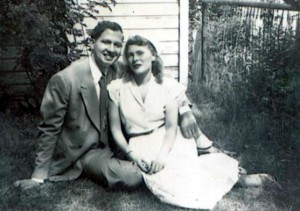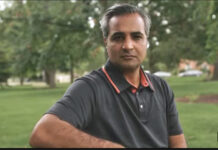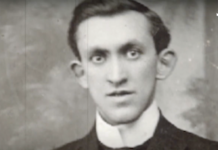By Mark Ellis —

Dr. Viggo Olsen has more than 20 letters of academic and professional achievement following his name, and is a diplomate of the American Board of Surgery. His brilliant surgical career is documented in the book, “Daktar: Diplomat in Bangladesh.”
At the beginning of his medical practice he believed in science, a view that held little room for religious faith. “I viewed Christianity and the Bible through agnostic eyes, feeling that modern science had outmoded much of this religious sentiment,” he recalls.
He began his internship in internal medicine at Long Island College Hospital in New York. During this period, his wife Joan’s parents challenged the young couple to attend church and investigate the claims of Jesus Christ. While he gave them some outward assurance they would attend, he wouldn’t say how often. He also told them he would make an impartial search for truth about the Bible, but inwardly, he had reservations. “We reluctantly agreed to study their ‘unscientific’ religion.”
Despite an outward appearance of objectivity, Dr. Olsen set out to prove “the Bible is not the word of God, that Christianity is not the true religion of God, and that Christ was but a man, not the son of God.”
Logically, Dr. Olsen thought he could review all the agnostic arguments that might undermine Christianity, then find the scientific mistakes in the Bible to complete his investigation. “Those mistakes in the Bible will prove it to be the word of men, not the word of some infallible creator,” he thought.
To please the Olsen’s in-laws, they found their way to the Bay Bridge Baptist Church in Brooklyn, led by Rev. E.A. Lockerbie. At the close of his sermons, Rev. Lockerbie gave invitations to believe in and follow Christ, which rankled Dr. Olsen. “I felt discomfort and resentment rising inside me. Why did I react so strongly to these invitations?” he wondered.
Their attendance at the church was sporadic, but eventually it became known to a few that they were agnostics. One day a young college student named Jack handed Dr. Olsen a book, “Modern Science and Christian Faith,” written by 13 scientists.
“Jack’s book opened the door into a whole new field of study previously unknown to us—Christian evidences,” he notes. “Boredom changed to interest, and interest became fascination as I mentally devoured the book.” The bibliography steered the Olsens to several other books of the same genre.
Certain facts became evident as the Olsens studied. “Scientifically we knew that planet earth and the surrounding universe had not always existed,” he says. “At one time they came into existence, which meant they must have been created by some mighty force or power.”
Was it intelligent power that brought the universe into existence or an undirected cosmic explosion? they wondered. Could there be design in the universe without a designer? Could the law of thermodynamics and other natural laws exist without a lawgiver?
Dr. Olsen had to admit there was unquestionable evidence of pattern and design in the universe and planet earth. “Millions of stars and planets track their courses precisely,” he observed. “The human body, whose design and function I had come to know so well, possesses a million different patterns in its many organs, groups of cells, and chemical systems.”
These patterns and designs led the Olsens to the conclusion that there was an intelligent power behind the universe. They realized that human beings possess something harder to quantify than power and intelligence — personality or soul, which brings the capacity for love.
While they became more certain that God might exist, it did not unhinge their agnosticism completely. It still left open the question of whether God revealed himself through the Bible or some other sacred writings.
They began to study other religions and came to some remarkable conclusions. “We found good ethics and good morality mixed with gross scientific error and sometimes, disturbing and degrading precepts,” he recalls. “We failed to find among them the mark of the supernatural.”
The Bible contrasted sharply with these other books. “We noted the remarkable unity and consistency evident in the Christian Scriptures. Despite the fact that its 66 books were written over 1600 years by more than 40 authors (some of them peasants and fisherman; others kings, physicians, and poets), the Bible books harmonized as though one person had supervised the writing of them all.”
To their surprise, they found the Bible to be historically accurate, with archaeological discoveries confirming biblical references.
“We discovered the Bible contains hundreds of detailed prophecies, written decades or centuries before the described events, which history acknowledges have been fulfilled in extraordinary ways.”
One of the more remarkable prophecies that caught Dr. Olsen and his wife’s attention came from the prophet Daniel, who predicted the coming of the Jewish messiah would be 483 years from the issuing of a certain decree to rebuild the city of Jerusalem, which had been destroyed by the King of Babylon.
“Sir Robert Anderson, a notable chief of Scotland Yard, actually counted the days covered by the prophecy (173,880 days). We were astonished to learn that his calculations placed the last day of the prophecy on the first Palm Sunday (April 6, A.D. 32).” This was precisely the day when Jesus rode into Jerusalem on the back of a donkey and the people proclaimed him “King of the Jews.”
As Dr. Olsen and his wife edged closer to the conclusion that God was real and the Bible historically accurate, it still didn’t answer their question about the deity of Jesus. “Is Jesus Christ the Son of God (deity united with humanity) and can he help us as he claimed? My answer was no. I believed Jesus to be a historical figure of ancient times. To attribute to him a supernatural birth, deity, or a part in the creation of the universe, seems preposterous,” Dr. Olsen thought.
As they poured over the life of Jesus recorded in the Gospel accounts they found all the roads converged at the death of Jesus and questions that swirled around his empty tomb.
“The resurrection of Christ became to us the hinge or crux of the whole question of the deity of Christ. If he did rise from the dead, we would have to grant that Jesus is the Son of God. And his rising from the dead could only mean, moreover, that all Jesus ever said is true and binding.”
Dr. Olsen also began to recognize he had a faulty view about the path to heaven. Before his exploration, he thought “Christianity teaches that if I do good works, lives a decent life, and don’t hurt anyone, those good acts will cancel out the bad, give me right standing with God, save me from hell, and someday launch me into heaven.”
“But I had missed it completely,” he realized. “Salvation from sin and a place in God’s family depends not on our good works, as I had thought, but on our true faith in Christ.”
Dr. Olsen recognized his “invincible” agnostic arguments were crumbling. “We were shaken by our failure to find scientific mistakes in the Christian Scriptures, and Christian evidences, a completely new field for us, had made a deep impression.”
Still, he continued to fight against the implications of his study. Joan, on the other hand, grew increasingly quiet when he argued against Christianity and the Bible. One day Dr. Olsen came home from work and shared a new argument against Christianity with her.
“But Vic, haven’t you really come to believe that Christ is the Son of God?” Joan asked. Something about her thoughtful look and tone toppled the final barricade in his mind.
In one electrifying moment, he realized Christianity was true. “In that unblinding flash of spiritual light I knew it was all true – Jesus is the Son of God – He did die for my sins according to the Scriptures – He did rise from the dead and prove it all true!”
Dr. Olsen received Jesus with all his heart. Jesus was no longer a distant concept. Suddenly, he believed Jesus is his “very own Savior – warm, alive, and very near.”
After a moment, Vic questioned Joan. “What about you?” he asked.
“I settled the matter several days ago,” she admitted, “but I was afraid to tell you. All the things we studied and learned finally convinced me about the Bible, about Christ, about my need – our need – for Him. So I prayed to God, confessing my sinfulness, and asked Christ to come into my heart and save me. And He did.”
In the “radiant days” that followed, everything seemed different to the young couple. When they discovered a biblical passage stating “Behold, all things have become new,” they understood the meaning at once.
Dr. Olsen’s heart overflowed with thanksgiving to God. “Oh, thank you, Father, for bringing me to this moment of faith, for loving and forgiving me, for granting me life everlasting. I’m looking forward to enjoying forever with you!”
If you want to know more about a personal relationship with God through Jesus, go here




tremendous! I’ve been sharing with a man with many near death experiences over the years……..He wasn’t ready for His final hour! I was looking for the right thing to share with him, and this is just what I was looking for and what I know that God will use to bring this man to Himself.! Thank you…………!
This is an Amazing Story!! I always had arguments with my science major friends in college about the Truth of Christ. It’s funny how many in the science field are atheist or agnostic when they are faced with the evidence of truth through God’s creation on a regular basis. My grandfather was in this camp for along time (agnostic). After he finished medical school and met my grandmother who had recently become a Christian he could not deny the evidence he had been facing all these years studying science and the amazing complexity of the human body. Science is what actually proved to my grandfathers head what his teachers had been trying to disprove. He accepted Christ and has been reaffirmed the Truth not only throughout his medical career, but of course in every aspect of his life. Truly amazing that even science leads people to Christ who try so desperately to deny Him through “empirical evidence”
Thank you, Mark!
I will pray about what to do with all of this!
Comments are closed.